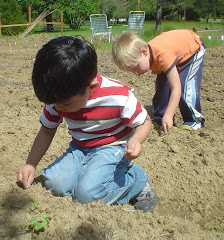Part of the "Sharing Garden's" Mission Statement is "to create a local and sustainable seed bank." We are looking for gardeners who are interested in learning the art of seed-saving and who would be willing to grow-out certain varieties of vegetables to save, and share the seed. If you have a garden patch, separated from other vegetable gardens by at least 500 feet, and would like to grow and save seed, please let us know and we will inform you of next steps. Once people let us know if they're interested in being involved, we'll have a meeting and decide who will grow what. We'll coach you along the way in how to grow the plants and save the seeds (if you need help). If you are an experienced local gardener and have some input that could help the rest of us to understand the finer points of seed-saving, please be in touch. We welcome your participation.
This notice is primarily directed towards gardeners who live near us, although we encourage our far-flung readers to initiate a similar project with gardeners in your own area. The more we can learn about growing our own food, storing it and saving seed, the more secure we will all be.
Before the days of Agri-business, Grange Halls had a vital function in farming communities. Not only did members of the local granges share large, expensive equipment (so each farmer did not have to own his or her own). But grange-members would also gather in the winter and agree on who was going to grow what. This was a valuable process so that a) farmers could rotate their crops and not overtax any one field by growing the same crop on it year after year, b) local communities were assured that there would be enough of the staple-crops to go around and c) for those farmers who were taking their crops to market, this planning assured that there would not be a glut on any one crop.
Most Grange Halls no longer serve these original functions. We, at the "Sharing Gardens" would like to re-introduce this idea on a smaller scale. It doesn't take a lot of room to grow most seed crops but, for the vegetables that easily cross-pollinate with other similar varieties, they should be isolated by 500 feet to a half mile from others with which they might cross.
For example, Sweet Meat and Butter Cup squash, if grown in the same patch will "cross" and you can't know which characteristics of the mother plants will carry through in their offspring. The next generation might be delicious but they could turn out to be woody or flavorless and, you wouldn't know until you've grown out the whole next generation.
Our intention with the Seed-Savers network is to encourage people to learn about the art of saving seed and to create more local food self-reliance. With participation from other experienced gardeners and seed-savers, we will learn about this important skill together. All levels of expertise are welcome.
Most Grange Halls no longer serve these original functions. We, at the "Sharing Gardens" would like to re-introduce this idea on a smaller scale. It doesn't take a lot of room to grow most seed crops but, for the vegetables that easily cross-pollinate with other similar varieties, they should be isolated by 500 feet to a half mile from others with which they might cross.
 |
| Butter Cup Squash |
Our intention with the Seed-Savers network is to encourage people to learn about the art of saving seed and to create more local food self-reliance. With participation from other experienced gardeners and seed-savers, we will learn about this important skill together. All levels of expertise are welcome.







































I intended to draft you the bit of remark to be able to say thank you over again over the breathtaking tactics you've featured at this time. This has been really strangely open-handed of people like you to convey freely precisely what most people could possibly have offered for sale for an e-book to help make some dough for themselves, especially considering the fact that you might have tried it if you ever wanted. These advice likewise served as the good way to be sure that some people have the same zeal the same as my very own to realize way more with respect to this condition. I know there are millions of more fun instances ahead for people who scan your site.
ReplyDelete